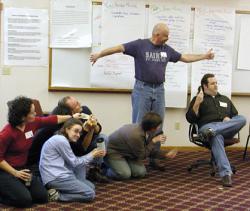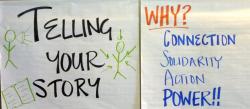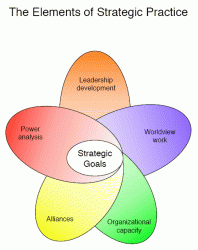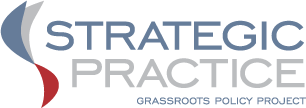Ideas in Action
“There’s nothing so practical as a good theory.” –– Kurt Lewin
GPP brings social movement theory into practice by mining the best ideas from social and political sciences, as well as from history, and applying these ideas to actual organizing –– base-building, alliance-building, campaign and electoral work. We evaluate and reflect on the ways groups apply ideas and theory to their work, which leads to further refinement of our ideas and training tools. We incorporate three core sets of ideas into our written materials and workshops: power analysis, worldview work and strategy development. In addition, we have a growing body of writings that flesh out our conceptual frameworks related to strategic practice.
Power Analysis
 We use the word power as a way of describing a set of relationships between and among people, taking place within an historical context and through given social structures. A tool for power analysis that we have found useful is the Three Faces of Power. Briefly, the three faces are: 1) direct political involvement; 2) organizational infrastructure; and 3) ideology and worldview. Applying the three faces to movement-building suggests that we need greater unity and clarity about what we believe, a more systemic approach to campaigns and agendas, better networking, and stronger alliances with other movement groups.
We use the word power as a way of describing a set of relationships between and among people, taking place within an historical context and through given social structures. A tool for power analysis that we have found useful is the Three Faces of Power. Briefly, the three faces are: 1) direct political involvement; 2) organizational infrastructure; and 3) ideology and worldview. Applying the three faces to movement-building suggests that we need greater unity and clarity about what we believe, a more systemic approach to campaigns and agendas, better networking, and stronger alliances with other movement groups.
Resources for power analysis:
Worldview Work
 Working on worldview, and locating our values, themes and beliefs within the context of worldview, helps us actively engage in the contest of ideas, or the third face of power. We unmask the dominant ideas that hold back fundamental change, while advancing alternative beliefs and values. Worldview work is a democratic process –– it is something people struggle with, develop and test out together. A key aspect of this work for groups is developing their own narratives. Groups use narratives as the basis for developing frames and messages.
Working on worldview, and locating our values, themes and beliefs within the context of worldview, helps us actively engage in the contest of ideas, or the third face of power. We unmask the dominant ideas that hold back fundamental change, while advancing alternative beliefs and values. Worldview work is a democratic process –– it is something people struggle with, develop and test out together. A key aspect of this work for groups is developing their own narratives. Groups use narratives as the basis for developing frames and messages.
Worldview resources:
- Worldview and the Contest of Ideas
- Using Worldview to Build Power
- Political Consciousness and Collective Action
- Alternatives to the Conservative Narrative
Strategy Development
 Achieving transformational social change requires bold vision linked with good analysis of current openings and opportunities, a division of labor and coordination among different kinds of groups, and a sense of intermediate steps that keep us on track toward the long-term goals. This is the essence of good strategy.
Achieving transformational social change requires bold vision linked with good analysis of current openings and opportunities, a division of labor and coordination among different kinds of groups, and a sense of intermediate steps that keep us on track toward the long-term goals. This is the essence of good strategy.
While most social change groups talk a lot about strategy, and engage in some form of strategic planning, there often is a gap between strategy and practice. In the heat of battle, social change groups can get caught up in short-term, day-to-day struggles and single-issue campaigns while losing sight of the longer-term goals. Changing internal practice is hard. This is why we work closely with a small number of groups over long periods of time, in concert with core staff and leaders.
Strategy resources include:
- Overview: Strategic Practice for Social Transformation
- Strategic Practice for Social Transformation
- Power and Social Change
- Strategic Planning and Strategy Development
Over the years, we have learned a great deal about how groups use power, worldview and strategy to bring their day-to-day actions into greater alignment with their long-term aspirations for social change. Our case study about ISAIAH’s strategic practice illustrates what we mean by aligning ideas and action.

